The Wye Valley Greenway
A new cycling path (but long overdue)
The "Covid19" word has scuppered my cycling plans for almost two years, but I'm still here and that's something I'm very grateful for (as many are not). Two old friends suggested we meet and go cycling on a route that hadn't long been opened (April 2021). This route should have opened years ago, but was held back by the local council (I believe). Now, due to an army of persevering campaigners, volunteers and supportive companies, this short, but noteworthy route is worth the ride. The 'Wye Valley Greenway' runs along part of the disused Wye Valley Railway trackbed, offering walkers and cyclists a sustainable way to visit the beautiful lower Wye Valley.
Sedbury to Tintern round trip (10 miles)
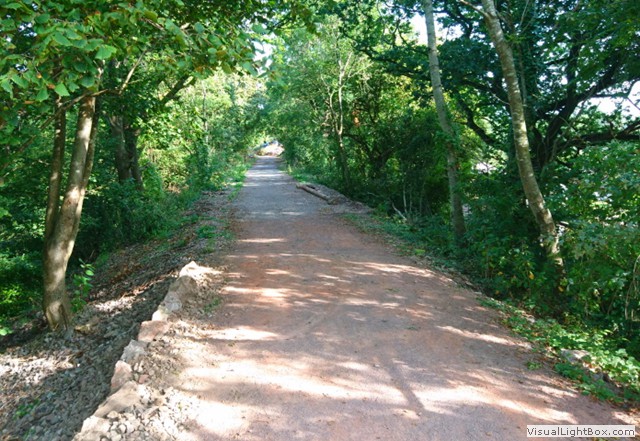 We met at a small cafe in Sedbury on a beautiful late summers day. Without prompt, the cafe owner invited us to bring our bikes inside the cafe, an acknowledgement of local bike thefts or courtesy and recognition of how valuable our bikes are, I think the latter. After a nice coffee, we headed off down Sedbury Lane and crossed the Snipe Hill Bridge over the mainline railway, here is the start of the Wye Valley Greenway on the former Wye Valley Railway. The railway route went to Monmouth, passenger services were abandoned over fifty years ago, but the railway continued in part as a goods line from Tintern Quarry (which closed in the 1980's). The path begins on hard packed gravel on a steady family friendly incline, we shortly approach the old Dayhouse Quarry, now 'The National Dive Centre of Wales', here is an alternative place to park and hire a bike if you wish. Tidenham station has been taken in hand by the Dive Centre and is now part of their annual 'Fear Fest' a Halloween event, so there's nothing left of the station except the edge of the platform. Just before the tunnel is an unusual road bridge, the main wrought iron arch of Bishton bridge is supported by a hotchpotch of square steel pillars that look period. On further investigation; these were added around twenty years ago (way after the line shut) to support the road bridge.
We met at a small cafe in Sedbury on a beautiful late summers day. Without prompt, the cafe owner invited us to bring our bikes inside the cafe, an acknowledgement of local bike thefts or courtesy and recognition of how valuable our bikes are, I think the latter. After a nice coffee, we headed off down Sedbury Lane and crossed the Snipe Hill Bridge over the mainline railway, here is the start of the Wye Valley Greenway on the former Wye Valley Railway. The railway route went to Monmouth, passenger services were abandoned over fifty years ago, but the railway continued in part as a goods line from Tintern Quarry (which closed in the 1980's). The path begins on hard packed gravel on a steady family friendly incline, we shortly approach the old Dayhouse Quarry, now 'The National Dive Centre of Wales', here is an alternative place to park and hire a bike if you wish. Tidenham station has been taken in hand by the Dive Centre and is now part of their annual 'Fear Fest' a Halloween event, so there's nothing left of the station except the edge of the platform. Just before the tunnel is an unusual road bridge, the main wrought iron arch of Bishton bridge is supported by a hotchpotch of square steel pillars that look period. On further investigation; these were added around twenty years ago (way after the line shut) to support the road bridge.
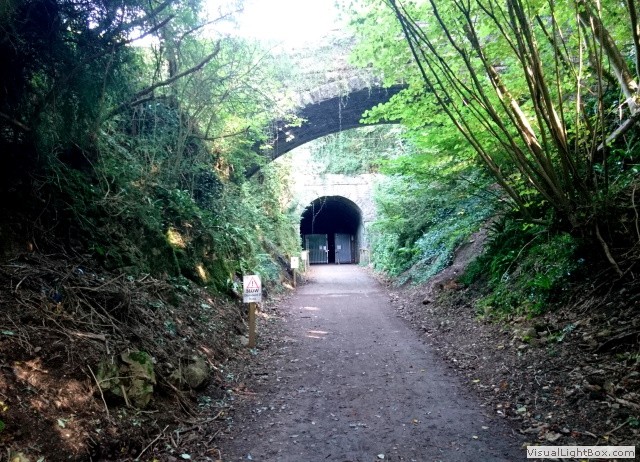 One hundred metres on is Tidenham Tunnel, gates shut the tunnel off at night (and the tunnel is completely shut in the winter) to protect the roosting lesser horseshoe bats. Torches and bike lights are prohibited, so dim, low level lights greet the visitor. It's disorienting at first, and combined with the distinct drop in temperature and the unseen drips of water, it gives the tunnel an eerie atmosphere. The tunnel trackbed curves to the left then slightly to the right giving the illusion that this underground section is far longer than it is. In fact, it's just over a kilometre long, but was still the longest tunnel on the Wye Valley Railway route, at its deepest point, the tunnel is only 100m below the surface. We come out into subdued speckled sunlight (due to the trees) and onto a path cut into Dennel hill, above the River Wye. You can see the river, but only if you stop. The conundrum; I think this path would be better ridden on a good winters day, as the summer leaves restrict the river views, but the tunnel isn't open in the winter.
One hundred metres on is Tidenham Tunnel, gates shut the tunnel off at night (and the tunnel is completely shut in the winter) to protect the roosting lesser horseshoe bats. Torches and bike lights are prohibited, so dim, low level lights greet the visitor. It's disorienting at first, and combined with the distinct drop in temperature and the unseen drips of water, it gives the tunnel an eerie atmosphere. The tunnel trackbed curves to the left then slightly to the right giving the illusion that this underground section is far longer than it is. In fact, it's just over a kilometre long, but was still the longest tunnel on the Wye Valley Railway route, at its deepest point, the tunnel is only 100m below the surface. We come out into subdued speckled sunlight (due to the trees) and onto a path cut into Dennel hill, above the River Wye. You can see the river, but only if you stop. The conundrum; I think this path would be better ridden on a good winters day, as the summer leaves restrict the river views, but the tunnel isn't open in the winter.
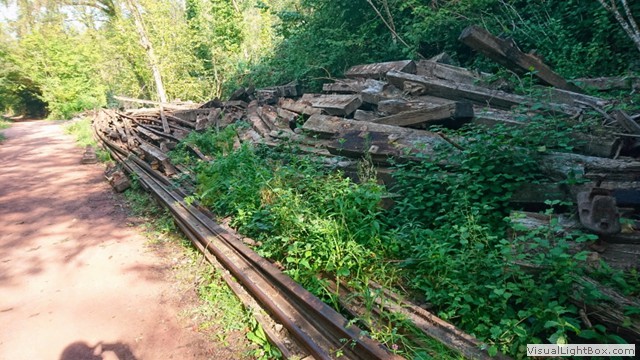 We pass a concrete wall which was the loading dock to transport stone from Tintern Quarry onto the waiting rail trucks. Further on are the dregs of the old line with steel rails and wooden sleepers dumped in a disorderly unloved pile. Continue on, the old railway line would have split here; to the right is Tintern Tunnel once through it, the line continued over the river and into Tintern Station (the bridge is long gone, hopefully in the future the tunnel and a new bridge will reopen that part of the route). I went through Tintern Station following the old Wye Valley Railway on a previous ride ending in Symonds Yat, click here to go to that ride. We continue west on the 'Wireworks Branch line' which once fed Abbey Tinplate Works. The path changes from a smooth ridable shale to a bumpy trail and suddenly through the trees is the Cistercian gothic masterpiece of Tintern Abbey. Ride (or walk) across the Wireworks Branch line bridge, I say 'walk' as sleepers on the bridge have warped and are now badly fitted together giving an unsettling feeling when riding across. The bridge was built at huge expense in 1875 to serve the Tinplate works of the Angidy Valley (a ride for another day), but the irony was that Abbey Tinplate Works went bankrupt before the line was able to open.
We pass a concrete wall which was the loading dock to transport stone from Tintern Quarry onto the waiting rail trucks. Further on are the dregs of the old line with steel rails and wooden sleepers dumped in a disorderly unloved pile. Continue on, the old railway line would have split here; to the right is Tintern Tunnel once through it, the line continued over the river and into Tintern Station (the bridge is long gone, hopefully in the future the tunnel and a new bridge will reopen that part of the route). I went through Tintern Station following the old Wye Valley Railway on a previous ride ending in Symonds Yat, click here to go to that ride. We continue west on the 'Wireworks Branch line' which once fed Abbey Tinplate Works. The path changes from a smooth ridable shale to a bumpy trail and suddenly through the trees is the Cistercian gothic masterpiece of Tintern Abbey. Ride (or walk) across the Wireworks Branch line bridge, I say 'walk' as sleepers on the bridge have warped and are now badly fitted together giving an unsettling feeling when riding across. The bridge was built at huge expense in 1875 to serve the Tinplate works of the Angidy Valley (a ride for another day), but the irony was that Abbey Tinplate Works went bankrupt before the line was able to open.
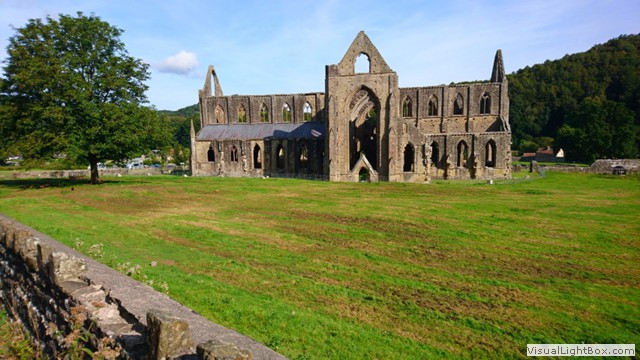 Breathing a sigh of relief (after crossing the wonky wireworks bridge) we're now on the west bank of the Wye, the lads decided to have a pint in the Wild Hare hotel (formerly the Royal George). I wanted to get a 360° visual of Tintern Abbey, still standing in roofless splendour, nearly 500 years since its tragic fall from grace. On the opposite side of the road is a younger derelict building, once the Abbey Hotel. Some of its buildings date from the early 1800s and have direct line of sight over Tintern Abbey. While the lads were happily testing the local beer, I decided to pop up to a hidden gem; The Church of St Mary The Virgin. Take the road opposite the Abbey Road (if you're looking at a Gothic pointed archway in a wall, you're in the right place) follow the road, and turn
Breathing a sigh of relief (after crossing the wonky wireworks bridge) we're now on the west bank of the Wye, the lads decided to have a pint in the Wild Hare hotel (formerly the Royal George). I wanted to get a 360° visual of Tintern Abbey, still standing in roofless splendour, nearly 500 years since its tragic fall from grace. On the opposite side of the road is a younger derelict building, once the Abbey Hotel. Some of its buildings date from the early 1800s and have direct line of sight over Tintern Abbey. While the lads were happily testing the local beer, I decided to pop up to a hidden gem; The Church of St Mary The Virgin. Take the road opposite the Abbey Road (if you're looking at a Gothic pointed archway in a wall, you're in the right place) follow the road, and turn
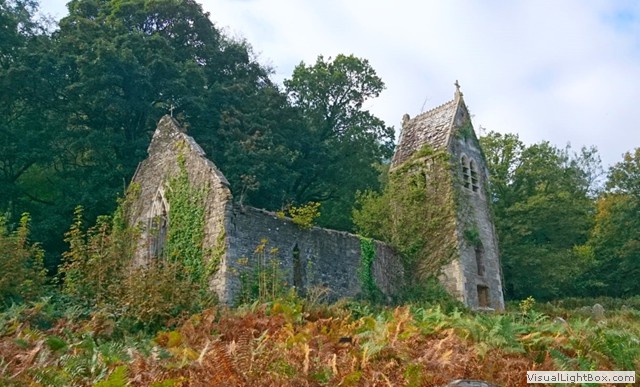 right at the 'Y' junction, just by a farm gate turn back on yourself to climb up to St Mary's on the old cobbled roadway. On the hillside west of Tintern Abbbey is the Grade II listed church building which served the people of Tintern. The views over the area are excellent and worth the 200m hike. The structure was destroyed by fire in 1977, but the shell is still beautiful, if a little scary (even in the day time). As the church (and graveyard) have been consumed by nature, take care going inside.
right at the 'Y' junction, just by a farm gate turn back on yourself to climb up to St Mary's on the old cobbled roadway. On the hillside west of Tintern Abbbey is the Grade II listed church building which served the people of Tintern. The views over the area are excellent and worth the 200m hike. The structure was destroyed by fire in 1977, but the shell is still beautiful, if a little scary (even in the day time). As the church (and graveyard) have been consumed by nature, take care going inside.
Tintern is a tourist honey pot, there's loads of nice places to have coffee or eat, the area is so green, it's a beautiful setting. Rejoining my comrades at the Wild Hare, I was warned by them they were considering putting a tracker app on my phone to stop me getting lost (believing I had gone the wrong way) and they mentioned something about dementia. Telling them about St Mary's didn't rebuke their teasing, with the 'can't beat them, join them' theory, I tried a few ales too. They say machinery works better when oiled, and the chaps were well oiled (that might explain why the journey back seamed to be much faster than the outward leg). Good job we caught the train to Chepstow.
-
Gallery
 Why not have a look at the gallery relating to this ride. Click the image or the title.
Why not have a look at the gallery relating to this ride. Click the image or the title. -
Sedbury shipbuilding
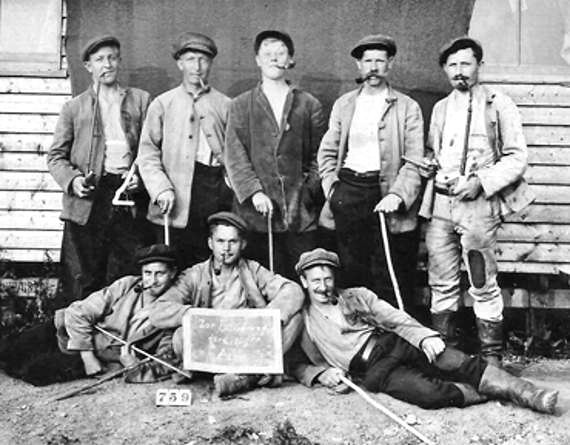 During WW1 the area around Chepstow was selected to build ships for the war. Beachley was set to house National Shipyard No.2, construction was in late 1917, and made use of prisoners of war. The villages of Beachley and Sedbury housed the German prisoners (click image for larger picture) and many of the original houses remain. Have a look at the panel on the side of the Towngate Surgery explaining the history.
During WW1 the area around Chepstow was selected to build ships for the war. Beachley was set to house National Shipyard No.2, construction was in late 1917, and made use of prisoners of war. The villages of Beachley and Sedbury housed the German prisoners (click image for larger picture) and many of the original houses remain. Have a look at the panel on the side of the Towngate Surgery explaining the history. -
The bats of Tidenham
 Tidenham tunnel is an important winter hibernation roost for Lesser Horseshoe bats which are protected under the Wildlife and Countryside Act. Over a quarter of the UK population of lesser horseshoe bats are thought to live in the Forest of Dean and lower Wye Valley
Tidenham tunnel is an important winter hibernation roost for Lesser Horseshoe bats which are protected under the Wildlife and Countryside Act. Over a quarter of the UK population of lesser horseshoe bats are thought to live in the Forest of Dean and lower Wye Valley -
Tintern station
 GWR hoped Tintern Abbey would bring hoards of tourists in the 1880s and indeed thousands did come on special trains, alighting here for the twenty minute walk to the Abbey. The station was built here and not in Tintern village, as the valley there was too narrow. Click the image to see it as it was.
GWR hoped Tintern Abbey would bring hoards of tourists in the 1880s and indeed thousands did come on special trains, alighting here for the twenty minute walk to the Abbey. The station was built here and not in Tintern village, as the valley there was too narrow. Click the image to see it as it was. -
Tintern medieval tunnel
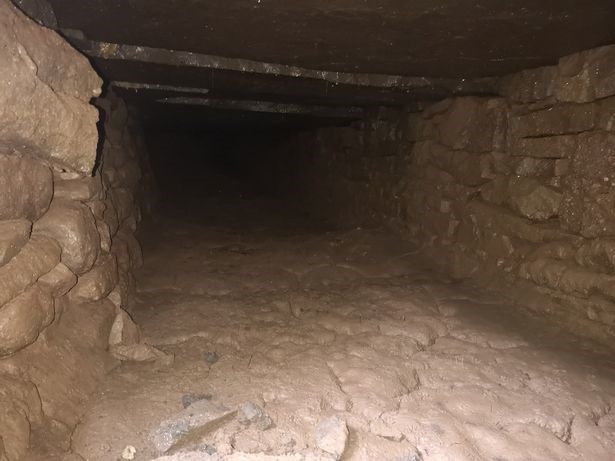 In 2021 a secret tunnel system was discovered by electrical technicians in south Wales. Western Power Distribution said the tunnels, near to the 12th Century Tintern Abbey, were not shown on any Ordnance Survey map. The 1.5m high tunnel was hidden underneath a footpath running parallel to Angiddy Brook.
In 2021 a secret tunnel system was discovered by electrical technicians in south Wales. Western Power Distribution said the tunnels, near to the 12th Century Tintern Abbey, were not shown on any Ordnance Survey map. The 1.5m high tunnel was hidden underneath a footpath running parallel to Angiddy Brook. -
St Marys fire
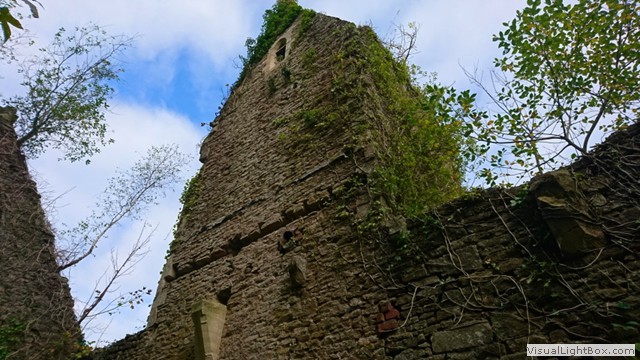 The medieval chapel was built as a retreat for the monks of Tintern Abbey. In the late 1800s, the graveyard laid to rest some of the workers from the Abbey Wire works, finally the church shut in 1972. Tragically, two youngsters lost their lives at night in a fire that consumed the Church, in July 1977.
The medieval chapel was built as a retreat for the monks of Tintern Abbey. In the late 1800s, the graveyard laid to rest some of the workers from the Abbey Wire works, finally the church shut in 1972. Tragically, two youngsters lost their lives at night in a fire that consumed the Church, in July 1977. -
Download gpx route from this ride.
 Click the road icon on the right to go to download page, click the appropriate icon and start enjoying some fantastic journeys.
Click the road icon on the right to go to download page, click the appropriate icon and start enjoying some fantastic journeys.
